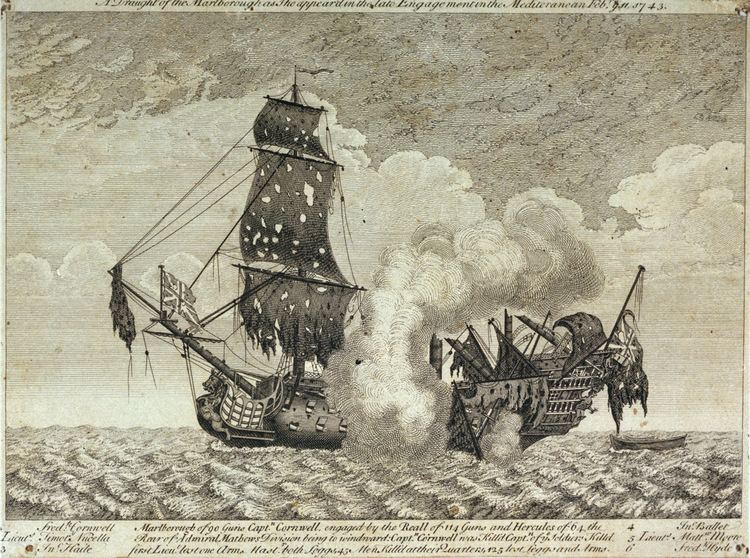Years of service 1708–1761 Service/branch Royal Navy | Name George Clinton Died July 10, 1761, England Rank Admiral of the Fleet | |
 | ||
Commands held HMS SpeedwellHMS MonckHMS NottinghamHMS ColchesterHMS SunderlandHMS NamurHMS BerwickHMS Prince FrederickHMS Marlborough Battles/wars War of the Spanish SuccessionWar of the Austrian Succession Battles and wars | ||
Admiral of the Fleet The Hon. George Clinton (c.1686 – 10 July 1761) was a Royal Navy officer and politician. Benefiting from the patronage of Thomas Pelham-Holles, 1st Duke of Newcastle he served as a naval captain during the 1720s and 1730s.
Contents
Clinton went on to be governor of the Colony of Newfoundland, Commodore and Commander-in-Chief of the Mediterranean Fleet and then Governor of the Province of New York where he had to deal with the threat of a French attack during King George's War. He could not cope with the liberal politicians of the New York assembly who were led by James De Lancey and resigned in 1753.
Clinton also served as member of parliament for Saltash, a rotten borough in Cornwall, from March 1757 until his death in July 1761.
Early career
Born the second son of Francis Clinton, 6th Earl of Lincoln and Susan Clinton (nee Penninston), Clinton joined the Royal Navy in 1708 during the War of the Spanish Succession. Clinton enjoyed the patronage of Thomas Pelham-Holles, 1st Duke of Newcastle, who was his sister-in-law's brother, and, having been promoted to captain on 16 June 1716, he was given command of the fifth-rate HMS Speedwell. He transferred to the command of the fourth-rate HMS Monck in 1720 and served in the Baltic Sea under Admiral Sir John Norris: the ship was lost during the return journey to England but Clinton was acquitted at the subsequent court-martial. He was given command of the fourth-rate HMS Nottingham in 1721 and sailed to the Baltic Sea to carry out patrols before returning home again in 1722.
After four years of inactivity, Clinton was given command of the fourth-rate HMS Colchester in the Mediterranean Sea in 1726 and saw action escorting merchant shipping, attacking Spanish batteries and blockading the Spanish coast before transferred to the command of the fourth-rate HMS Sunderland in July 1727. In 1732 Clinton was appointed commodore of a squadron of ships which was despatched to Newfoundland where he also became governor of the colony. In that role he supervised the newly appointed local magistrates and protected the local fishing industry.
Clinton took command of the second-rate HMS Namur as flag captain to Admiral Sir Charles Wager in June 1732 and then transferred to the command of the third-rate HMS Berwick in the Channel Fleet in 1734. He went on to be Commodore and Commander-in-Chief of the Mediterranean Fleet in 1736 but, with the War of Jenkins' Ear looming, he stepped down to take command of the third-rate HMS Prince Frederick in 1739 and of the second-rate HMS Marlborough in 1740 during the War of the Austrian Succession.
Governor of New York
Heavily in debt, Clinton lobbied the Duke of Newcastle for profitable employment as an American governor: he was appointed Governor of the Province of New York in July 1741 and arrived in New York in September 1743 to take up his position. Promoted to rear-admiral on 10 December 1743 and vice-admiral on 23 June 1744, he sought to protect New York's Northern border from attack by the French: however liberal members of the New York assembly resisted his proposals as they wanted to maintain trade links with the French and with the native americans who were under French influence.
James De Lancey, who had initially been his main adviser, turned against him and sought to block the governor's salary. Clinton therefore invited Sir William Johnson to take over responsibility for native american affairs in 1746 and appointed Cadwallader Colden to be his advisor. Clinton was promoted to full admiral on 15 July 1747. Working with the Mohawk chief Hendrick Theyanoguin, Johnson was able to recruit Mohawk warriors to fight on the side of the British in 1747 during King George's War. After continuing disputes with the assembly over military expenditure and payment of the governor's salary, Clinton resigned as governor in October 1753.
Later career
Clinton was elected member of parliament for Saltash, a rotten borough in Cornwall, in May 1754. Promoted to Admiral of the Fleet in March 1757, he died on 10 July 1761.
Family
Clinton was married to an heiress, Anne Carle: their children included General Sir Henry Clinton, who became a British commander in the American Revolutionary War, and Lucy Mary Clinton, who married Admiral Robert Roddam.
